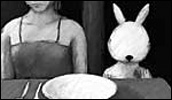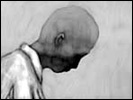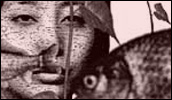Thinking and Drawing: Japanese Art Animation of the New Millennium
- Year
- 2005
- Original title
- Shinkingu Ando Doroingu Nihon no Shinseiki Ato Animeshon
- Japanese title
- シンキング アンド ドローイング 日本の新世紀アート・アニメーション
- Director
- Running time
- 78 minutes
- Published
- 23 April 2007



by Catherine Munroe Hotes
The walls of video rental shops in Japan are lined with hundreds upon hundreds of animation DVDs, but experimental and art animation on DVD are rare. To remedy this situation, Image Forum put together this showcase of the work of contemporary avant-garde animators trained in Kyoto and Tokyo. Image Forum has been the centre for the creation, exhibition, and distribution of alternative film in Tokyo for over twenty-five years. In the early days, it was known as the Underground Center but renamed itself in 1977 when they established the Institute for Moving Images, where they train students in experimental film and art animation techniques.
Released in 2005, Thinking and Drawing features a wide selection of animation styles from line drawing to CGI manipulated photographs. The subject matter ranges from feminist allegory to ghostly tales. Although each film has a short running time of between 5 and 17 minutes, the depth of meaning in each is truly astonishing. The films have shown together and separately at festivals in Europe, North America, and Australia.
Along with Tabaimo (Ayako Tabata), Maho Shimao, and Atsuko Udo, Mika Seike represents a growing number of women in experimental film. Seike's films are instantly recognizable by their signature monotone backgrounds and human figures. The shades of black and white vary in texture, sometimes giving one the impression of old newsprint, while at other times having the texture of birch-bark or handmade paper. When accompanied by the sound of electronic feedback it reminded me of the static on a disconnected television.
Seike's films have a feminist edge and tackle difficult questions about the relationship between women and men as well as the relationship between people and the environment. Place Where There Are Moths (Ga no Iru Tokoro, 2001) depicts the conflict between drab concrete block apartment living and the natural environment in Japanese cities. The forces of nature are represented by the motif of a tree whose leaves metamorphose into orange moths and take over a middle-aged woman's apartment, pushing her room higher and higher within the building. Each apartment is like a block in the video game Tetris, an impression confirmed by the use of sound effects from the addictive game. The Tetris motif adds humour, but also represents the dehumanizing force of modernity in this poetic film.
Another deeply allusive film by Seike on this DVD is Dialogue Between Two (Nisou no Kuzu, 2004). The dialogue in question takes place between a woman, who appears to be submerged in water, and a man who sits by a tree on sandy soil. The messages the couple sends back and forth to one another take the form of metaphor: a seed, a fish, a thorn, and so on. After a couple of messages, it becomes clear that what appears to be water from the woman's perspective is sand from the man's perspective. Like Seike's other films, Dialogue Between Two is open to many interpretations but it is certainly fascinating viewing and shares many themes and motifs with Hiroshi Teshigara's adaptation of Kobo Abe's Woman in the Dunes (Suna no Onna, 1964).
The description of Suwami Nogami's minimalistic line drawing piece, Imagination Practice (Kangaeru Renshu, 2003), calls it an unending "thought loop". It depicts an artist sitting in front of a window with a self-portrait, like a miniature mirror image, on the desk in front of him. The window frame and the blue sky filled with moving clouds are in colour, but the figure of the artist is not coloured in. The soundtrack sounds like a skipping record that is punctuated by humourous springing noises (a la Bugs Bunny) as the image 'bounces' in an unending loop from the establishing shot into the "drawing." A philosophical piece, Imagination Practice considers the circular dialogue between an artist and his work.
Kei Oyama's work generally possesses an air of melancholia. Both The Thaw (Yuki Doke, 2004) and Consultation Room (Shinsatsu-shitsu, 2005) concern themselves with modern fears concerning illness (both mental and physical), deformity and death. Despite the often disturbing content and surreal imagery, there is something hauntingly beautiful about the way in which the animation has been rendered. It has something to do with the softness of edges, which have the appearance of smudged charcoal. The Thaw has drawn inspiration in theme and soundtrack from David Lynch's cult classic Eraserhead (1977). A fascinating film but not recommended for the faint-hearted or depressed.
Takashi Ishida, who is also known for his installation art, experiments with the use of real spaces in his animated films. Gestalt (Heya/Keitai, 1999) was shot over the course of a year in a Tokyo dormitory. Each day, Ishida would paint on the wall and photograph it using the available light from the window. The 7-minute long film, which is accompanied by haunting organ music composed by J.S. Bach, consists of those several seconds of film Ishida shot daily. The wonderfully flowing lines and play of geometric patterns result in a quiet, contemplative piece that is stylistically reminiscent of Norman McLaren's experiments with music and animation.
Tetsuji Kurashige's nightmarish U-SA-GUI (2002) begins by citing a section from Brillat-Savarin's 1825 treatise, The Physiology of Taste, in which the renowned French epicure suggests that stimulating foods, meats in particular, can have an influence on one's dreams. The film depicts a macabre game played by two rabbits and a blindfolded woman. The rabbits face each other over an old-fashioned illustrated board game. When they land on a square, the woman must eat the food indicated in the illustration. If she has chosen correctly, a die pops out of her mouth and lands on the floor giving the rabbits their next move.
The rabbits have been drawn in the style of Shinto statues, meaning that their ears are shorter and more pointed than Dick Bruna's Miffy or Sanrio's My Melody - the two kinds of bunnies currently most dominant in Japanese popular culture. The film has a nostalgic feel to it, not only because of the style of the rabbits, but also due to elements of the mise-en-scene such as the backdrop of a large Japanese-style window and the use of a phonograph in one scene. Adding to the nostalgia is the artist's use of white on black intertitles that feature the two rabbits on either side of a kanji, illustrated in the traditional style often featured on stationery (particularly for the Year of the Rabbit). Kurashige combines charcoal line drawings with CGI to produce a film that is as beautiful as it is disturbing.
The longest film on the DVD at 17 minutes, A Feather Stare at the Dark (Yami o Mitsumiru Hane, 2003) may also have taken the longest to create. Naoyuki Tsuji is famous for his unique charcoal art animation technique in which he draws on an easel and photographs the image, then partially erases what he has drawn and draws over it for the next frame. He repeated this process thousands of times over the course of eight years to create this dream-like film. Tsuji seems to take a stream-of-consciousness approach to his work, letting each image flow steadily into the next one fueled by the inspiration of the moment. The resulting film explores themes of sexuality, creation, and mythology in a way that reminded me of the oeuvre of Jean Cocteau.
Kaidan is a slightly old-fashioned term meaning ghost story. The term, in its older romanization 'Kwaidan' was made famous in the West by Lafcadio Hearn in his 1904 collection of ghostly Japanese tales. The title is appropriate for Norihiko Iki's somewhat nostalgic 2003 film. Iki mixes old and new technologies to create a film that evokes both the sights and sounds (hum of cicadas) of a hot Japanese summer. Black and white photographs of a Shinto shrine, summer landscape and an old Japanese-style house provide the backdrop and CGI technology adds the visual interest in the form of an unusual little girl and her ghostly frog companion. The ghost in this story is more a curiosity than something scary, and the use of a fish-eye lens and other distortions suggest both the sweltering humidity of summer and also imply that the frog is an imaginary creation of the young protagonist. A visual treat and one of my favourite films in this collection.
Bonus features on this DVD include brief biographies and filmographies of all the artists as well as excerpts from Takeshi Ishida's film From Three Shores and clips of Naoyuki Tsuji sitting at an easel working on his latest film Three Clouds. The reverse side of the DVD cover is the board game from U-SA-GI. After watching Kurashige's twisted film I would advise playing this game at your own risk.